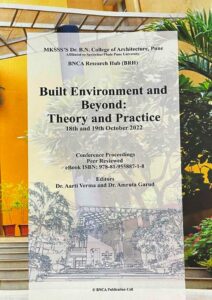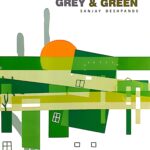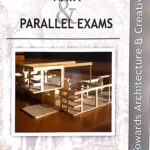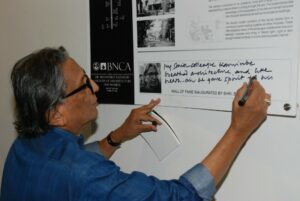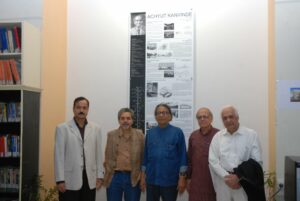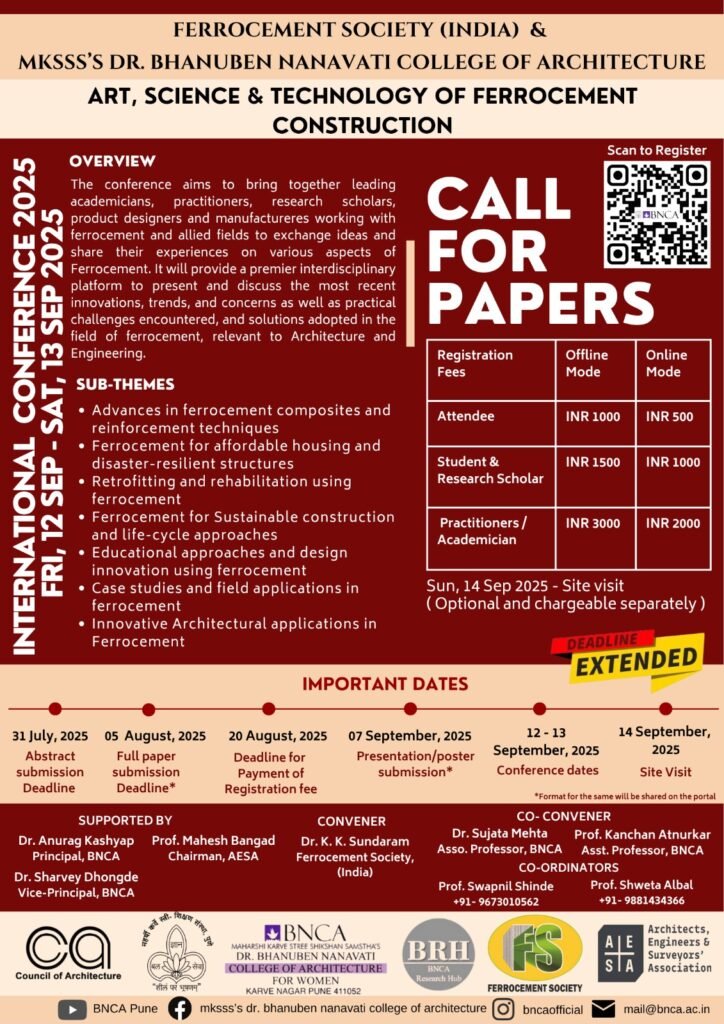- Home
- About Us
- Programs
- Accreditation
- Research
- BNCA Cells
- International Cell
- UNAI
- Universal Design Cell
- Innovation and Incubation Cell
- Archineering Cell
- Environment Cell
- Publication Cell
- IQAC (Internal Quality Assurance Cell)
- BNCA Consultancy Cell ( BCC )
- CEL (Center For Ecological Landscapes)
- Universal Human Values
- SES RE CELL
- Structure Cell
- Center For Cultural Studies
- Teaching+Learning Laboratory
- Career Counselling & Guidance Cell
- Center for Interdisciplinary Studies in Art and Architecture.
- Students
- Infrastructure
- Library
- IT Infrastructure and Computer Labs
- Digital Fabrication Lab
- Wood Working Lab
- Lab for Environmental and Simulation [LEDS]
- Landscape Research Lab
- Material Museum
- Construction Lab
- Survey And Leveling Lab
- Language Lab
- Studios
- Photography Lab
- Clay Studio
- Immerssive Design Lab
- Acoustic Lab
- Board Room
- Auditorium
- Lighting Lab
- Research
- Contact Us
Publication Cell
Dr. Bhanuben Nanavati College of Architecture, BNCA, is one of the several institutes functioning under the aegis of Maharshi Karve Stree Shikshan Samstha.The BNCA Publication Cell has been active since 2009, when we published our very first book. It has been our long standing dream to make the Cell a source of valuable and quality academic publications and we began our journey towards that goal with the publication of our book on Padmashree Architect Achyut Kanvinde, the doyen of Modern Indian Architecture.
The fact that the book was released by none other than Architect Balkrishna Doshi, another founder of contemporary Indian Architecture and Pritzker awardee, is a matter of great pride for the Institute.
We have continued this journey with several other books that are listed in our Catalogue.
Vision- Mission
BNCA Publication Cell aspires to cultivate and nurture a thriving literary ecosystem with an inclusive approach that embraces literature from all fields allied to Architecture by encouraging literary contributions from industry, academia and other professionals. Our mission is to produce literature that has the capacity to engage all kinds of readers.
RECENT


Living Wisdom (e book)
e ISBN : 978-81-955887-2-5
Published in 2024
Editor: Swati Sahasrabudhe
Co-editor: Anupama Bapat
Living Wisdom: A Pedagogical Journey Through Asudbaug’s Riverine Cultural Landscape
“Living Wisdom” is a profound exploration of the riverine cultural landscape of Asudbaug in Konkan, Maharashtra, India. Rooted in the venerable ‘paat’ system—an age-old testament to sustainable water management—this book delves into the intricate relationship between land, river, and community through the lens of landscape architecture. Developed through meticulous research, fieldwork, and design exploration, Living Wisdom presents a holistic perspective on how human settlements interact with their natural environment. Each chapter unfolds a new dimension of Asudbaug’s landscape, from its indigenous water conservation practices to the architectural vernacular that embodies the ethos of the region. At its core, this book showcases the work of students who have documented, analyzed, and reimagined Asudbaug’s living landscape with a focus on sustainability, cultural preservation, and community engagement. Their innovative design proposals and thoughtful interventions offer insightful pathways for enhancing the resilience and vitality of this historically rich terrain. More than just a collection of research and designs, Living Wisdom is a testament to the power of education, collaboration, and interdisciplinary inquiry. It serves as an inspiration for future generations of designers, scholars, and environmental stewards, reminding us of the transformative impact that thoughtful design and cultural sensitivity can have on shaping a more sustainable world. Through this book, readers are invited on a journey where the wisdom of the past converges with the vision of the future—where landscape itself becomes a living narrative of human ingenuity and ecological stewardship.
2) BNCA National Conference Proceedings

Built Environment and Beyond 2.0 : Theory and Practice 2nd and 3rd November 2023
e-ISBN: 978-81-955887-9-4
Published in 2024
Paperback
Edited by Dr. Avanti Bambawale, Prof Siddhi Joshi , Prof. Mandar Athavale
The built environment today is not limited to just individual buildings but also encapsulates the surroundings, urban patterns and morphology, social and political circuits, services and innovations in technology. The multidisciplinary nature of the built environment has brought a shift in the way we perceive architecture and environment around. With the paradigm shift there have been transformations in architectural practice, theory and pedagogy. This shift has presented various lenses and tools to explore the tangible and intangible aspects of built-unbuilt environment. The National Conference organized by BNCA titled “Built Environment and Beyond 2.0: Theory and Practice” aimed at addressing this multidisciplinary nature of the architecture and allied disciplines. The conference invited papers from academicians, professionals, students and research scholars and encouraged them to explore this multifaceted nature of the built environment. Papers were invited under the themes of Architecture and Planning, Landscape and Ecology, Art and Humanities, Environment, Culture and Heritage Conservation, Emerging Technology and Services.
- BNCA National Conference Proceedings
Built Environment and Beyond : Theory and Practice
18th and 19th October 2022
e ISBN : 978-81-955887-1-8
Published in 2022
Paperback
Edited by Dr. Aarti Verma and Dr. Amruta Garud
The first national conference of BNCA Research Hub (BRH) was held on October 18-19, 2022, on a virtual platform. The theme of the conference was ‘Built Environment and Beyond: Theory and Practice’.
Architectural designs have not just illustrated creative thinking, technological innovations and space optimization strategies but have also challenged and motivated the built and the un-built environment. With the emerging innovations, dynamic tools of creation, and changing paradigms of practices and education, it becomes worthwhile to study the role and challenges that Architecture discipline portrays today. Such deliberations could also provide an impetus for insightful research towards a desired future. Based on this premise, the Research Conference aimed at contemplating the quality of built environments reflected through theory and practice.
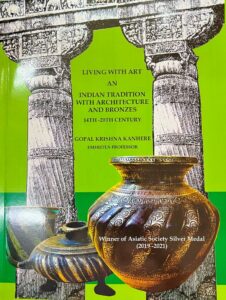
- Living with Art
An Indian Tradition with Architecture and Bronzes
14th – 20th Century
ISBN : 978-81-920642-6-0
Published in 2021
Paperback
Priced at INR 1700/-
Author : Ar. Gopal Krishna Kanhere, Emeritus Professor
Prof. G. K. Kanhere is an avid collector of bronzes in general and from Deccan and Western India in particular, for the last 40 years.
Working for the then Prince of Wales Museum Mumbai, as an architect , the author got exposed to the field of antiques and therich heritage of India. The seed of this remarkable parallel development which resulted in the creations in both architecture and bronze is very striking in some artifacts like the Mashal or Torch, or the shape of some betel nut crackers. Slowly the idea has germinated, grew, matured, evolved and emerged in the form of this manuscript.
The dresses, rituals, festivals and the socio cultural references with the observed continuity of the many traditions makes the bronze artefacts relevant today. Some of these events, rituals, dresses, musical instruments are recorded with the bronze artefacts making this a different anthropological, architectural study.
The author’s work on Indian silver and study of bronzes has led me to appreciate the multiplicity of ways that Indian craftsmen relate to both their natural environment and architecture. Most of all, with this study, the socio cultural dimension is also presented.

- Prastara
Lessons from the past to adapt for the future
ISBN : 978-81-955887-0-1
Published in 2017
Paperback
Edited by Dr. Sujata Karve, Prof. Namrata.D
This publication is a documentation of the studio project undertaken to understand Jaipur city from the past to the present and was done in alignment with the curriculum to study environmental design and putting theories of sustainable development into practice, by the students of environmental architecture.
Our project has tried to defining urban resilience, connecting theory to practice, and highlighting tangible examples of how cities are responding to the range of new and enhanced challenges they are facing. Building urban resilience relies on multiple interventions at different scales and has many different professional and practical entry points. The project aimed to address the call put forward by the ACCCRN (Asian Cities for Cliimate Change Resilient Network), which has been pioneered by the Rockefeller foundation.
‘Prastara’ demonstrates the possibility of a city to take shape to enhance the overall living conditions of the neighbourhood of Pratap nagar and subsequently all the rapidly developing peri-urban areas which can adopt strategies defined here to cater to various changing climatic conditions giving a perspective on a climate resilient city from a built form standpoint.
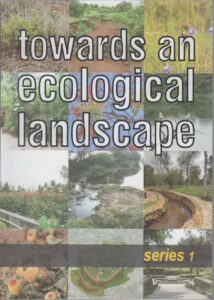
- Towards an Ecological Landscape
ISBN 978-81-920642-5-3
Published in 2018
Paperback
Priced at INR 625/-
Edited by Ar. Swati Sahasrabuddhe, Ar. Peeyush Sekhsaria and Parikshit SuryavanshiTowards an Ecological
Landscape with its theme (Pune and its environs) is the 1st series (TEL-1 2015). This book published by BNCA Publication Cell holds an array of articles which carry the essence of 14 presentations delivered by experts from varied fields such as ecology, botany, landscape architecture, water management, forest conversation, environment, urban planning and design, environmental sciences. The book consists of valuable bundle of knowledge about ecological landscapes to explore your own scope towards future liveable and sustainable environment.
Link for Amazon sale of the book : Click Here
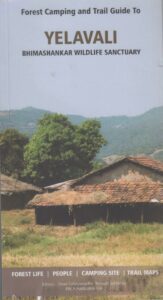
- Yelavli
Bhimashankar Wildlife Sanctuary
ISBN 978-81-920642-2-2
Published in 2017
Paperback
Priced at INR 320/-
Edited by Ar. Swati Sahasrabuddhe and Ar.Peeyush Sekhsaria, this book is documentation of ecological aspects of Yelavali village in Bhimashankar Wildlife Sanctuary and its surrounding areas based on the field studies carried out as part of Master’s in landscape architecture studio on ecology. This book intends to capture the ecological essence of the setting through the language of graphics and imagery. The book contains the documentation, trail map and analysis of the natural habitats and the associated resources in a given setting. The book hopes to serve as a demonstrative guide for people of all age groups and backgrounds camping at Yelavali Village, helping them have a deeper experience with nature and the people of Yelavali.
Link for Amazon sale of the book: Click Here
BACKLIST
- Shades of Grey and Green
Published in 2014
Paperback
Priced at INR 700/-
Author: Sanjay Deshpande
This book talks of the urban issues that our city faces. This book provokes people to think and act for the betterment of our living environment. Through these pages one finds various shades of ‘grey’ and ‘green’, where all greys stand for concerns and greens for delight. Through these narratives, the author conveys his own point of view. The author, who is a builder by profession , ensures that all the construction works and schemes developed under his leadership are predominantly user and environment friendly.
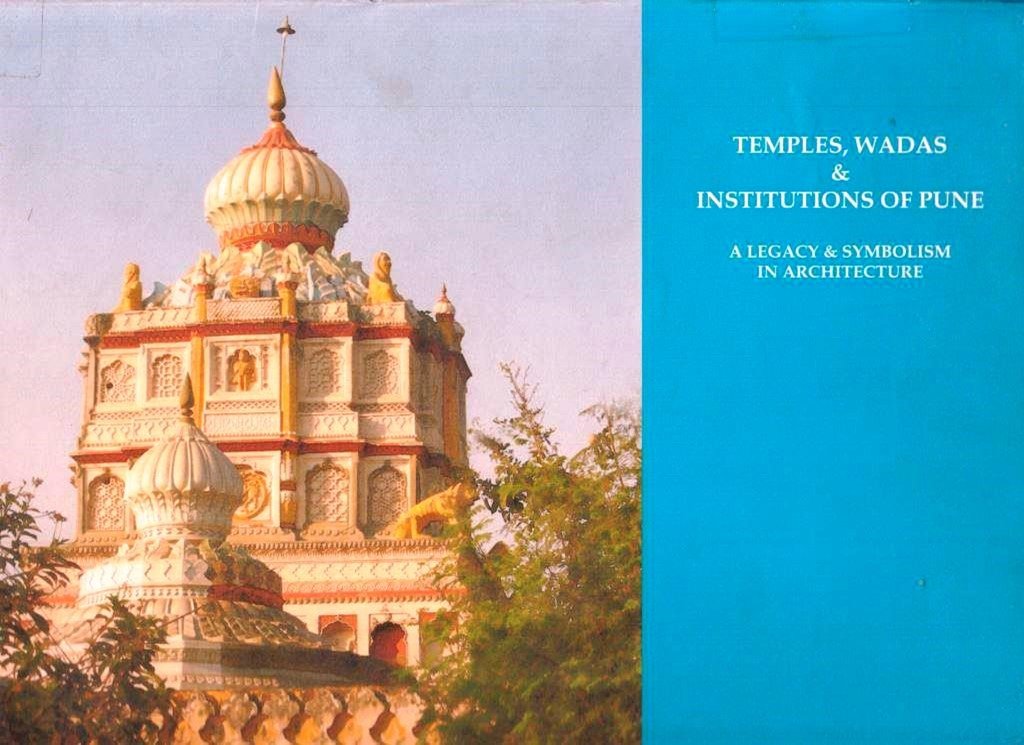
- Temples, Wadas and Institutions of Pune
ISBN 978-81-920642-3-9
Published in 2013
Hardback
Priced at INR 2700/-
Author: Ar. Gopal Krishna Kanhere
This book is an illustrated Architectural documentation and evaluation of some 43 select and significant Heritage Temples , Wadas and institutions which adorned the city of Pune.They span a period from 10th century to early 20th century .Enthusiasm about conservation and heritage with expanding tourism has created a need for such a book.It is also as a mission to create public awareness and appreciation of the rich heritage of Maratha and Peshwai Architecture. Richly illustrated, it provides valuable data of wadas, temples as well as some colonial buildings like Deccan college.
- Inclusive India Re : Pune
ISBN 978-81-920642-4-6
Published in 2012
Hardback
Paperback priced at INR 700/-
Authors : Tina Wik & Ar. Sharvey Dhongde
This book is an output of the Studio collaboration between the post masters program of the Royal Institute of Art, Stockholm KKH and the masters program of BNCA, Pune in the year 2011-12.The focus was on the problems created by fast growing Indian cities, where no adequate planning tools exist for safeguarding their historic parts. The book showcases the work performed during the study year 2011-12 developed to a proposed Action Plan for an Urban Conservation plan for Pune Historic City
- Nata and Parallel Exams
Published in 2010
Paperback
Priced at INR 350/-
Author : Ar. Anshul Gujrathi
This book helps to develop techniques for scoring at the various tests like NATA, MHCET (Arch) , AIEEE(Arch), NID Entrance and Intermediate Drawing exam. The book intends to bring out the latent aptitude for Architecture that today’s young generation has. This book gives complete study of topics stated in the exam syllabus along with general information and basic Architectural History.
The entire test is based on exercises evaluating the creativity and aptitude. For those who have the aptitude but are unaware of it, this book is a great help. The book is amply illustrated by diagrams, pictorial representations and color schemes.
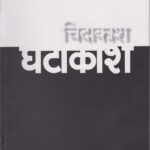
Chidakash Ghatakash
ISBN 978-81-920642-1-5
Published in 2010
Paperback
Priced at INR 350/-
Author: Ar. Prof Arun Ogale Edited by Ar. Chetan Sahasrabuddhe
This book is a compilation of selected articles authored by Prof. Arun Ogale from 1969 to 2009. His lucid style that appeals to not only Architects , but also familiarizes the common man with Architecture. The book speaks about Indian and Foreign Master Architects through fine examples of ‘unbound space’ and ‘bound space’, lending the book its name
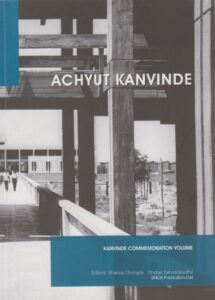
- Achyut Kanvinde
ISBN 978-81-920642-0-8
Published in 2009
Paperback
Priced at INR 450/-
Edited by Ar. Sharvey Dhongde and Ar. Chetan Sahasrabuddhe
This is the very first book published by the BNCA Publication Cell, which is a commemorative volume on the works of the first Indian Modernist, Padmashree Ar. Achyut Kanvinde. The Kanvinde commemoration volume is a part of the Kanvinde Memorial lecture series mooted by Prof. Arun Ogale and largely comprises of three sections viz. Kanvinde’s biography, his works and writings and tributes paid to him by his contemporaries, B. V. Doshi, Charles Correa and Ar. Anant Raje. The included works bring out Kanvindes’ intellectual rigour and his mastery as a form maker.
The fact that the book was released by Ar. B.V. Doshi, is a matter of great pride for BNCA.
2. Newsletters & Periodicals
Current publications
1)BNCA Newsletter
Our monthly newsletter showcases all the happenings at BNCA. This includes achievements of students and faculty, news about academic, co-curricular and extra-curricular activities like workshops, guest lectures, site visits, settlement studies and celebrations at BNCA.Prof. Smita Ogale is the editor of the Newsletter.
2)BUILD-TEXT
BUILD-TEXT is a half yearly publication of the Archineering Cell. The first issue was published in 2016. Prof. Poorva Kulkarni is the chief editor of this publication. All members of the Archineering Cell contribute to this publication. Every issue is based on a topic or a theme and contributors to the topic are Faculty and students.
Discontinued Publications
1)LANTURN
LANTURN stands for Landscape Turning Point, a newsletter of the Masters department of Landscape Architecture at BNCA.The first issue was published in March 2009 and was followed by several issues showcasing students projects of documentation, teachers training programmes and various activities of the Landscape Department. The last published issue was in April 2011.
2)ENREACH
ENREACH – a half yearly newsletter of the Masters department of Environmental Architecture at BNCA, looks at the department works, news, etc. along with an article based on a theme.There have been no new issues since 2018. It would be revived as an e-newsletter with a 6 monthly frequency.
2025
January Newsletter: Click here
February Newsletter: Click here
2024
February Newsletter: Click here
March Newsletter: Click here
July Newsletter: Click here
August Newsletter: Click here
2023
February Newsletter: Click here
March Newsletter: Click here
April Newsletter: Click here
August Newsletter: Click here
October Newsletter: Click here
November-December Newsletter: Click here
2022
June-July Newsletter: Click here
August Newsletter: Click here
October Newsletter: Click here
November Newsletter: Click here
December Newsletter: Click here

Prof. Smita Ogale
BNCA Publication Cell Head
(With a team of Faculty, Students and Administration)
email: smita.ogale@bnca.ac.in
Mentored by:
Dr. Anurag Kashyap
Principal, BNCA

